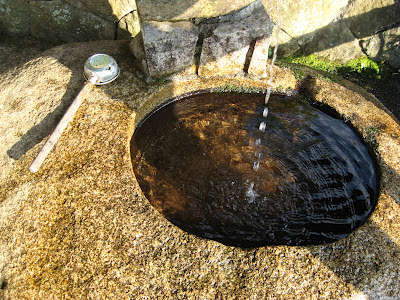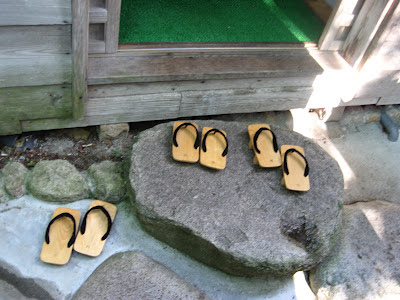 | |||
| Welcome to Murasugiyu, a Bucolic Hot Spring Village |
I discovered a pleasant, simple outdoor hot spring bath (露天風呂) in Niigata Prefecture today. No jets, no electricity, no herbs. At the start of my bath, I was alone, which was perfect for being able to absorb the
heat, to dissipate stress, and to space out with my back against a warm rock while enjoying patterns in the cedar and maple branches and leaves above. Soon
afterwards, though, another man entered the hot spring. We exchanged short, polite greetings. Then, we withdrew into our private thoughts.
The man's back, shoulders, and wide swaths of his legs were covered with colorful Japanese tattoos of dragons, warriors, and other Japanese designs, types that are associated with members of the Yacuza. However, he spoke politely; he
was friendly without invading my privacy, and he graciously accepted
my request to take a photograph of me with my camera. Before leaving, he said "Osaki ni shitsuri shimase," which roughly translates as "Excuse my rudeness in leaving before you." His courteous manner left a good impression.
In contrast, shortly after the Yakuza member departed, one of the three men who came together into the hot spring bath stared at me, didn't greet me, but roughly asked where I was from. I politely answered and then submerged myself in the healing warmth of the clear water and greenery surrounding the outdoor bath. Their conversation, though, was rather loud, so I learned that they were government officials visiting from another prefecture.
The contrast in the manners of the four men that I met in the outdoor bath was remarkable, considering the stereotypes of Yakuza and how certain Japanese public officials are reacting to people with tattoos. A Japanese newspaper on May 23, 2012, reported that the mayor of Osaka said, "Citizens feel uneasy or intimidated if they see tattoos (on workers) in services, and it undermines trust in the city.“ Click to read another article about tattoos in Japan.
To enter the bath, you must purchase a three hundred yen ticket from an automatic vending machine at a gate before the spring and place that ticket in a wooden box next to the vending machine. Remember to your shoes off before walking into the tiny wooden shed-like building which has a changing room and small lockers for each sex. The bath is enclosed within wooden fences, but you can still enjoy views of trees and bamboo from within. The sides of the bath were built from rocks that the locals had collected from the nearby mountain. The rocks were positioned to form comfortable backrests or seats in the hot spring.
There is little development in the area, so the hot water rising from the bowels of the earth, and the cool water running through gurgling streams, are crystal clean. In addition to enjoying the healing hot spring waters, many visitors fill up containers with fresh spring water and take those back home.
A local tofu shop called Kawakami Tofu (川上とうふ)uses this mountain water to make tofu, and the shop is very popular. I was so impressed by the free samples of five varieties of tofu, that I purchased some for dinner.
 |
| Murasugi Community Outdoor Bath |
In contrast, shortly after the Yakuza member departed, one of the three men who came together into the hot spring bath stared at me, didn't greet me, but roughly asked where I was from. I politely answered and then submerged myself in the healing warmth of the clear water and greenery surrounding the outdoor bath. Their conversation, though, was rather loud, so I learned that they were government officials visiting from another prefecture.
The contrast in the manners of the four men that I met in the outdoor bath was remarkable, considering the stereotypes of Yakuza and how certain Japanese public officials are reacting to people with tattoos. A Japanese newspaper on May 23, 2012, reported that the mayor of Osaka said, "Citizens feel uneasy or intimidated if they see tattoos (on workers) in services, and it undermines trust in the city.“ Click to read another article about tattoos in Japan.
To enter the bath, you must purchase a three hundred yen ticket from an automatic vending machine at a gate before the spring and place that ticket in a wooden box next to the vending machine. Remember to your shoes off before walking into the tiny wooden shed-like building which has a changing room and small lockers for each sex. The bath is enclosed within wooden fences, but you can still enjoy views of trees and bamboo from within. The sides of the bath were built from rocks that the locals had collected from the nearby mountain. The rocks were positioned to form comfortable backrests or seats in the hot spring.
There is little development in the area, so the hot water rising from the bowels of the earth, and the cool water running through gurgling streams, are crystal clean. In addition to enjoying the healing hot spring waters, many visitors fill up containers with fresh spring water and take those back home.
 |
| Collecting Fresh Spring Water for Drinking |
 |
| Listen, Then Taste the Fresh Dripping Water |
Walking through the village and along some trails nearby were pleasant experiences. Taking into consideration the price, the ambiance, and the quality of the water, I conclude that I will definitely visit again to explore more of this quaint and relaxing village. There are other hot springs waiting for me!
Click to find this bucolic village on a map.
.
Click to find this bucolic village on a map.
.

Thanks Bill. If you stay indoors, you can avoid the horseflies, and you can choose hot springs in areas without horseflies, for example, hot springs on the roofs of buildings, hot springs by the sea, or hot springs in caves.
ReplyDeleteA wonderful commentary on the healing springs and observations of Japanese culture. I enjoy reading your posts.
ReplyDelete